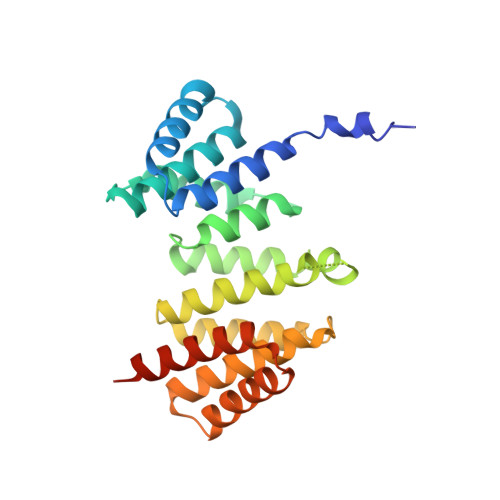Structural and functional analysis of RopB: a major virulence regulator in Streptococcus pyogenes.
Makthal, N., Gavagan, M., Do, H., Olsen, R.J., Musser, J.M., Kumaraswami, M.(2016) Mol Microbiol 99: 1119-1133
- PubMed: 26714274
- DOI: https://doi.org/10.1111/mmi.13294
- Primary Citation of Related Structures:
5DL2 - PubMed Abstract:
Group A Streptococcus (GAS) is an exclusive human pathogen that causes significant disease burden. Global regulator RopB of GAS controls the expression of several major virulence factors including secreted protease SpeB during high cell density. However, the molecular mechanism for RopB-dependent speB expression remains unclear. To understand the mechanism of transcription activation by RopB, we determined the crystal structure of the C-terminal domain of RopB. RopB-CTD has the TPR motif, a signature motif involved in protein-peptide interactions and shares significant structural homology with the quorum sensing RRNPP family regulators. Characterization of the high cell density-specific cell-free growth medium demonstrated the presence of a low molecular weight proteinaceous secreted factor that upregulates RopB-dependent speB expression. Together, these results suggest that RopB and its cognate peptide signals constitute an intercellular signalling machinery that controls the virulence gene expression in concert with population density. Structure-guided mutational analyses of RopB dimer interface demonstrated that single alanine substitutions at this critical interface significantly altered RopB-dependent speB expression and attenuated GAS virulence. Results presented here suggested that a properly aligned RopB dimer interface is important for GAS pathogenesis and highlighted the dimerization interactions as a plausible therapeutic target for the development of novel antimicrobials.
- Center for Molecular and Translational Human Infectious Diseases Research, Houston Methodist Research Institute, and Department of Pathology and Genomic Medicine, Houston Methodist Hospital, Houston, TX, USA.
Organizational Affiliation:
















